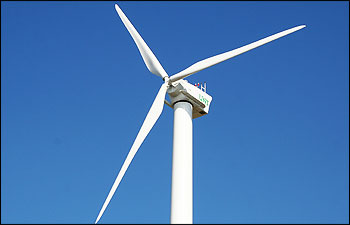Green energy is all the rage, and Ohio is jumping on the bandwagon with little regard for financial considerations. The proposed offshore wind turbine project in Lake Erie is an example of wasteful spending in the name of going green and creating jobs.
Initially, this project is supposed to include five turbines – the first of their kind in North America. These turbines, to be built by 2012, will cost about $100 million and, advocates say, create as many as 600 jobs.
If the pilot project succeeds, 1,200 turbines will be built in Lake Erie over 20 years. The complete project will cost $31 billion and could create as many as 8,000 jobs, according to a recent economic impact study.
But the wind turbines are a bad proposition for Ohio. Of the $31 billion, only $7.8 billion will go toward wages; the rest will go to infrastructure, equipment, and other costs. In terms of wages, creating each job will cost $975,000.
During the 20 years of construction, state and local governments would collect only $587 million in tax revenue from the project. Thus, the initial $31 billion investment would not be recovered by taxes, excluding interest payments, for 1,050 years.
Since the life span of well-maintained offshore turbines is only 30 to 40 years, it will be impossible for investors, public or private, to recover what they put into the project. If government completely financed the project, it still would owe nearly $30 billion when the likely usefulness of the original turbines expired.
If the initial cost is not enough of a deterrent, the uncompetitive price of energy that the turbines would produce should be. Electricity from the offshore turbines is expected to cost 23 cents per kilowatt-hour. By contrast, electricity from Ohio’s land turbines costs roughly 9 cents per kilowatt-hour, while electricity from coal costs only 4 to 6 cents.
Because of subsidies from the U.S. Department of Energy, stimulus funds, and help from state government, proponents say Ohioans would not bear the brunt of these increased energy costs. But this is simply not the case. Ohioans would pay for the offshore wind turbines through their taxes, if not through consumer fees.
Finances aside, the turbines are impractical. There is skepticism about whether the turbines could withstand winter ice. Engineers believe waves and wind also could cause significant stress to the turbines’ foundations.
State government faces an $8 billion budget shortfall next year, while many local governments struggle to make ends meet. This is not the time to undertake a risky project that would cost nearly four times as much as the projected state deficit.
Ohioans endure the seventh highest state and local tax burden in the country. Adding to that burden to fund unnecessary, impractical projects will prolong our state’s fiscal pain.
The emerging alternative-energy industry creates some jobs and is more environmentally friendly than the traditional energy industry, but it comes with a high cost. Artificially propping up green energy with subsidies not only is expensive but also destroys jobs in Ohio’s traditional energy sector.
Green energy might be the wave of the future. But until it can be produced more cheaply than traditional alternatives, it is a bad deal for Ohio taxpayers.
This article was written by Mary McCleary while she worked at the Buckeye Institute and originally appeared in The Toledo Blade.

